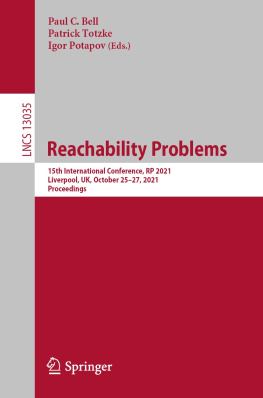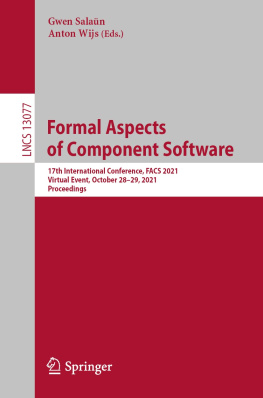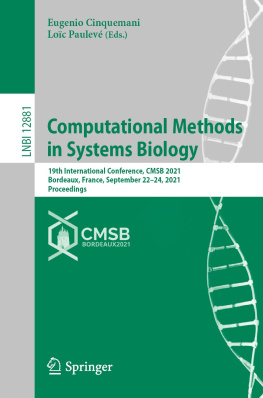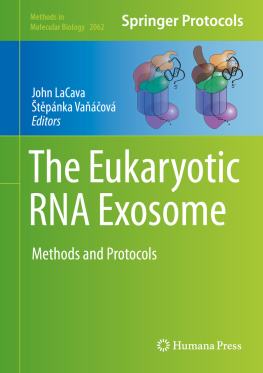Kazutaka Katoh - Multiple Sequence Alignment: Methods and Protocols
Here you can read online Kazutaka Katoh - Multiple Sequence Alignment: Methods and Protocols full text of the book (entire story) in english for free. Download pdf and epub, get meaning, cover and reviews about this ebook. year: 2020, publisher: Humana, genre: Children. Description of the work, (preface) as well as reviews are available. Best literature library LitArk.com created for fans of good reading and offers a wide selection of genres:
Romance novel
Science fiction
Adventure
Detective
Science
History
Home and family
Prose
Art
Politics
Computer
Non-fiction
Religion
Business
Children
Humor
Choose a favorite category and find really read worthwhile books. Enjoy immersion in the world of imagination, feel the emotions of the characters or learn something new for yourself, make an fascinating discovery.
- Book:Multiple Sequence Alignment: Methods and Protocols
- Author:
- Publisher:Humana
- Genre:
- Year:2020
- Rating:3 / 5
- Favourites:Add to favourites
- Your mark:
- 60
- 1
- 2
- 3
- 4
- 5
Multiple Sequence Alignment: Methods and Protocols: summary, description and annotation
We offer to read an annotation, description, summary or preface (depends on what the author of the book "Multiple Sequence Alignment: Methods and Protocols" wrote himself). If you haven't found the necessary information about the book — write in the comments, we will try to find it.
Multiple Sequence Alignment: Methods and Protocols — read online for free the complete book (whole text) full work
Below is the text of the book, divided by pages. System saving the place of the last page read, allows you to conveniently read the book "Multiple Sequence Alignment: Methods and Protocols" online for free, without having to search again every time where you left off. Put a bookmark, and you can go to the page where you finished reading at any time.
Font size:
Interval:
Bookmark:

For further volumes: http://www.springer.com/series/7651 For over 35 years, biological scientists have come to rely on the research protocols and methodologies in the critically acclaimed Methods in Molecular Biology series. The series was the first to introduce the step-by-step protocols approach that has become the standard in all biomedical protocol publishing. Each protocol is provided in readily-reproducible step-by step fashion, opening with an introductory overview, a list of the materials and reagents needed to complete the experiment, and followed by a detailed procedure that is supported with a helpful notes section offering tips and tricks of the trade as well as troubleshooting advice. These hallmark features were introduced by series editor Dr. John Walker and constitute the key ingredient in each and every volume of the Methods in Molecular Biology series. Tested and trusted, comprehensive and reliable, all protocols from the series are indexed in PubMed.
For over 35 years, biological scientists have come to rely on the research protocols and methodologies in the critically acclaimed Methods in Molecular Biology series. The series was the first to introduce the step-by-step protocols approach that has become the standard in all biomedical protocol publishing. Each protocol is provided in readily-reproducible step-by-step fashion, opening with an introductory overview, a list of the materials and reagents needed to complete the experiment, and followed by a detailed procedure that is supported with a helpful notes section offering tips and tricks of the trade as well as troubleshooting advice. These hallmark features were introduced by series editor Dr. John Walker and constitute the key ingredient in each and every volume of the Methods in Molecular Biology series. Tested and trusted, comprehensive and reliable, all protocols from the series are indexed in PubMed.

This Humana imprint is published by the registered company Springer Science+Business Media, LLC, part of Springer Nature.
The registered company address is: 1 New York Plaza, New York, NY 10004, U.S.A.
This volume is a collection of protocols to install and run tools for calculation and visualization of multiple sequence alignment (MSA) and other analyses related to MSA. Following the policy of Methods in Molecular Biology, each chapter basically consists of a brief background and a step-by-step guide for installation and actual analyses. Practical advice is also given in the Notes section in most chapters. The main target audience is experimental biologists who want to run MSA tools themselves. By reading a chapter in this volume, a reader should easily acquire basic usage of the associated tool. Detailed background and advanced usage are described in papers and/or webpages mentioned in each chapter.
To provide background for these chapters, this section explains some technical terms and established techniques that are commonly used.
Sequence alignment is an estimation of corresponding sites in a set of biological sequences. The correspondence is, in many cases, based on homology, i.e., shared ancestry in evolutionary history of the sequences compared. Alignment of just two sequences is called pairwise sequence alignment, and alignment of three or more sequences is called multiple sequence alignment, MSA, the theme of this volume. There is a long history of the study of sequence alignment methods, starting from the first application of the dynamic programming (DP) algorithm to pairwise alignment by Needleman and Wunsch [1]. This method gives the optimum pairwise alignment under a reasonable scoring system. It is theoretically possible to extend the DP algorithm to three or more sequences, if the score is derived as the summation of pairwise alignment scores. However, this calculation requires unpractical computational resources. In addition, for a real MSA, it is also usually necessary to consider the relationships between sequences in order to reflect their evolutionary history. Thus, the simple extension of the DP algorithm for MSA is rarely used. Instead, various heuristics are used. Representative heuristic techniques are outlined below.
A reasonable and widely used heuristic is the progressive method [24]. In this strategy, a tentative tree, called a guide tree, is built based on an all-to-all approximate comparison. Then, the sequences are aligned from the leaves to the root on the tree, in a group-to-group manner. When the calculation reaches the root, the full MSA is obtained. Many MSA programs use the progressive method as a part of the calculation. Among them, PRANK (Chapter ) has a notable point that it rigorously considers insertions and deletions on the guide tree.
The progressive method has a well-known problem that errors can occur in early steps (i.e., close to a leaf) of the guide tree, and those errors remain in the final step (the root of the guide tree). One effective solution is to correct this type of mistake is iterative refinement [57]. The procedure is: (i) construct an initial MSA; (ii) divide the MSA into two groups; (iii) re-align the two groups; repeat (ii) and (iii). This technique is used in Prrn5 (Chapter ).
Font size:
Interval:
Bookmark:
Similar books «Multiple Sequence Alignment: Methods and Protocols»
Look at similar books to Multiple Sequence Alignment: Methods and Protocols. We have selected literature similar in name and meaning in the hope of providing readers with more options to find new, interesting, not yet read works.
Discussion, reviews of the book Multiple Sequence Alignment: Methods and Protocols and just readers' own opinions. Leave your comments, write what you think about the work, its meaning or the main characters. Specify what exactly you liked and what you didn't like, and why you think so.












